Hallstatt (Hallstatt)
Related Places
Overview
In the picturesque Salzkammergut region of Upper Austria, nestled between towering mountains and the tranquil waters of Lake Hallstatt, lies the enchanting village of Hallstatt. With a history that spans over 7,000 years, this small village is often regarded as one of the most beautiful places in Austria, captivating visitors with its stunning landscapes and rich cultural heritage.
Hallstatt's journey to prominence began with its abundant salt deposits. The name "Hallstatt" itself is derived from "Hall," the ancient Celtic term for salt. Around 800 BC, the Celts started mining salt in this area, establishing one of the world's earliest known mining operations. This practice not only brought wealth but also allowed the village to flourish as early settlers dug deep shafts into the mountains to extract the precious mineral.
By the Middle Ages, Hallstatt emerged as a key player in the European salt trade. Its picturesque yet isolated location against the mountains and lake posed transportation challenges. To facilitate trade, villagers ingeniously built boats to ferry heavy salt across Lake Hallstatt to waiting markets. This method remained in use until the 19th century when modern transportation methods began to take over.
One of Hallstatt's iconic landmarks is the Hallstatt Salt Mine. Today, it serves as a popular tourist attraction, inviting visitors to explore ancient mine shafts and learn about the history of salt mining. The mine features a mesmerizing underground salt lake and a wooden slide that miners used to move swiftly between levels, offering a unique glimpse into the past.
The cultural and architectural fabric of Hallstatt is as rich as its mineral wealth. The village is adorned with charming buildings, many dating back to the 16th century, showcasing a unique blend of Gothic and Baroque styles. Narrow, cobbled streets wind through a sea of pastel-colored houses, leading to the bustling Market Square, where locals and tourists alike gather to enjoy the vibrant atmosphere.
At the heart of Hallstatt's spiritual life is St. Michael's Chapel, built in the 12th century. Inside, visitors can find the intriguing Beinhaus (Bone House), which houses over 600 painted skulls—a captivating yet macabre tradition that began in the 18th century due to limited space in the village cemetery.
The arrival of tourists in the 19th century marked a new chapter for Hallstatt. By the late 1800s, a scenic railway line was constructed, connecting Hallstatt to the rest of Austria and bringing a steady stream of visitors eager to experience its natural beauty and rich history.
Throughout the 20th century, Hallstatt embraced its cultural heritage while adapting to modern tourism. The village has successfully balanced the preservation of its ancient character with the needs of contemporary visitors. In 1997, Hallstatt was officially recognized as a UNESCO World Heritage site, solidifying its status as a place of global historical and cultural significance.
Today, Hallstatt thrives as a tourist destination, renowned for its breathtaking scenery and deep-rooted history. Visitors from around the globe flock here to stroll along the lakeside, explore the salt mines, and marvel at the well-preserved architecture. Nature enthusiasts can also hike the numerous trails that offer stunning vistas of the surrounding mountain ranges.
Despite its popularity, Hallstatt retains a sense of timeless tranquility. The village continues to embody the spirit of its industrious ancestors, beautifully blending natural beauty with a profound respect for its historical roots. Whether drawn by its ancient mines, stunning landscapes, or charming village life, Hallstatt promises a unique and unforgettable glimpse into Austria's rich cultural heritage.









